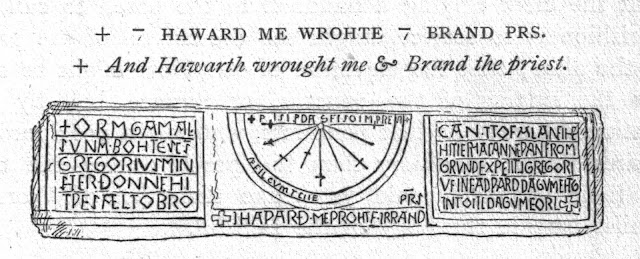I had been reading about the history of this part of Yorkshire all morning yesterday and this church at Kirkdale had cropped up. Situated between Helmsley and Kirkbymoorside, half a mile of the main road we visited it in the afternoon. Set at the end of a lane, no houses around but surrounded by thick woods, it stands a place of peace and quiet. It had quite a large cemetery around it, which gave it a slightly Gothic character. Dedicated to St.Gregory it would have been a Saxon Minster, serving several parishes in the district 'was where the old, ruined, minster church had stood in days gone by, the ruined church whose cemetery was still used by the local people for the burial of their dead.'
The cemetery is still used today, there is a little war cemetery as well, fenced of, but eloquent in its setting.In the walls of the old rebuilt church are the gravestone (These are gravestones of Anglo-Scandinavian design introduced to northern and eastern England by the Danes and Norwegians who settled here in the late ninth and early tenth centuries). of the Anglo-Scandinavians that were buried at a later date, apart from the Saxon knot work above which can be found in the east wall, these large stone crosses lie in the south facing wall, there is a further one on the west wall......
What survives of Orm's church in the existing visible fabric appears to be the south, west, and what remains of the east walls of the nave; That quote of course needs some explaining, for in the front porch there is a sun dial, which gives fascinating detail of when the dial was made, its history can be found here and an interpretation of the words. The sun dial sits above the church doorway,
 |
 |
 |
| What would we do without our Victorian ancestors who copied and wrote down everything in their everlasting curiosity about everything historic... the words are analysed in the link above.
To quote; Short though it is, this inscription provides us with a surprising amount of information. Most important of all, it enables us to date the earliest phase of the existing fabric with some precision. Tostig, the son of Earl Godwin of Wessex and the brother of Harold II the last Anglo-Saxon king of England, was earl of Northumbria from 1055 to 1065. It was therefore during that decade that Orm the son of Gamel rebuilt St. Gregory's church, It is very rarely that we can date the construction of an early medieval church so precisely. So there is even a date for this part of history, a rare and valuable truth.
Inside the church two finely decorated coffin slabs of an earlier date;
http://www.ascorpus.ac.uk/catvol3.php?pageNum_urls=58&totalRows_urls=288
To quote on these tomb slabs; Expert scholarly opinion would date these to the Anglian or pre-Scandinavian period (i.e. before c.870): one of them appears to be of the eighth century and the other of the ninth. On the strength of this dating the history of the church on this site may be caned back to c.750, conceivably even earlier. For their day they are very handsome pieces which display craftsmanship of a high order. Furthermore, certain features of their design strongly suggest that they originally stood inside a church, These indications show that the persons once buried beneath them were of great status and prestige. The church, which originally housed these tombs, may well have been an imposing one. I suspect the stone 'tasselling' on the edge makes these tomb stones something to be found inside the church, and out of the weather.
Saxon quoins below.....
 |








St Gregory's is one of my favourite places to visit - we never pass without stopping and having a walk round.
ReplyDeleteIt is a very atmospheric place, expect we shall do that as it is very close.
ReplyDelete